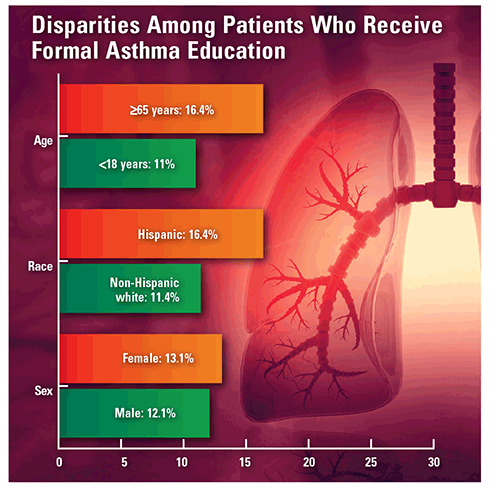US Pharm. 2019;44(7):Epub.
According to the Healthy People 2020 initiative, health disparities exist in certain educational aspects of asthma care. Current data revealed that only 12.1% of asthma patients receive formal education about the disease from their healthcare provider (HCP). There was a large disparity in asthma-related education between patients with advanced degrees and patients with some college education (20.8% vs. 10.7%). Marginally more asthma patients without disabilities than those with disabilities (12.9% vs. 11.9%) received formal asthma-related education. A disparity between types of health insurance coverage was evident between adults with public health insurance and adults who were uninsured (13.7% vs. 9.8%).

Patient Concern and HCP Advice: A small number of adult patients (14.4%) asked their HCP if their asthma was work-related, and 16.2% of males versus 13.6% of females voiced this concern. Patients with less than a high school education more frequently asked this question compared with patients with a 4-year college degree (19.5% vs. 13.8%). Patients who were uninsured expressed more concern than those who were covered by public health insurance (15.4% vs. 9.8%). Nearly one-half of asthma patients were advised by their HCP to make adjustments in their home, school, or work environments to reduce exposure to irritants or allergens to which they were sensitive.
Asthma-Management Plans: The National Asthma Education and Prevention Program (NAEPP) has published guidelines on asthma management, including patient education, written plans, and follow-up medical visits. Approximately 33% of asthma patients received an appropriate written asthma-management plan. More than three of every five asthma patients received education about appropriate response to an episode—including recognizing early signs and symptoms and monitoring peak-flow results according to NAEPP guidelines—from their HCP. Nearly 58% of asthma patients had at least one routine follow-up medical visit, with visits made by marginally more females than males (57.5% vs. 56.6%). A disparity existed across educational levels in asthma patients, with those who had less than a high school education making more HCP visits than those who had an associate degree (55.7% vs. 48.8%).
Instructions on Inhaler Use: Most asthma patients (95.9%) received instructions on inhaler use, and most lived in a metropolitan area (96.4%). Adult asthma patients with private insurance more often received such instructions compared with those with public insurance (96.8% vs. 93.4%). More patients aged 18 to 44 years than those aged 45 to 64 years (96.3% vs. 94.9%) received instructions. Asthma patients with less than a high school education were less likely than those with a high school education to receive instructions (93.3% vs. 96.3%).
To comment on this article, contact rdavidson@uspharmacist.com.






